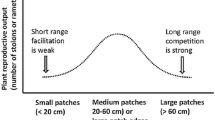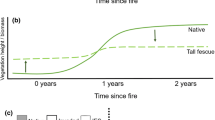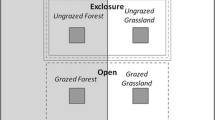Abstract
A linear, semi-theoretical relationship between the coverage change of plant communities due to spatial processes and a partial patchiness index of the community distribution patterns in a grassland landscape was established by partitioning the overall coverage change into a spatial increment caused by species migration and a local increment due to local ecological processes. This relationship implies that patchiness of grassland landscapes can accelerate either recovery or degradation of a community, depending on the environmental conditions depicted by a parameter termed as gradient strength. The established relationship also has potential applications in simulating pattern dynamics of plant community distributions for a grassland landscape using a spatially homogeneous patch-scale model.
The derived linear relationship was applied to a one-hectare alkaline grassland observatory in northeast China. Gradient strengths of two major plant community types were determined via linear regression from simulation results for selected subregions of the grassland. The calibrated linear relationship was then applied to the rest of the grassland landscape. Preliminary comparisons with complete spatial simulations and observations indicated that using this linear relationship with a patch-scale model can simulate the coverage changes as accurately as using a comprehensive spatial simulation model.
Similar content being viewed by others
References
Baker, W.L. 1989. A review of models of landscape change. Landscape Ecology 2: 111–133.
Burrough, P.A. 1986. Principles of geographical information systems for land resources assessment. Clarendon Press, Oxford, UK.
Gao, Q., Zheng, H. and Li, J. 1996. A dynamic landscape simulation model for the alkaline grassland on Songnen Plain in northeast China. Landscape Ecology 11: 339–349.
Gardner, R.H., Milne, B.T., Turner, M.G. and O'Neill, R.V. 1987. Neutral models for the analysis of broad-scale landscape pattern. Landscape Ecology 1: 19–28.
Li, H. 1989. Spatio-temporal pattern analysis of managed forest landscapes: A simulation approach. Ph. D. dissertation, The Oregon State University, Corvallis, Oregon, USA.
Li, H. and Reynolds, J.F. 1993. A new contagion index to quantify spatial patterns of landscapes. Landscape Ecology 8: 155–162.
Li, J. and Zheng, H. 1994. sOptimal Management Models for Alkaline Grassland in Northeast China, Science Press of China, Beijing, China (In press).
O'Neill, R.V., Krummel, J.R., Gardner, R.H., Sugihara, G., Jackson, B., DeAngelis, D.L., Milne, B.T., Turner, M.G., Zygmunt, B., Christensen, S.W., Dale, V.H., and Gradham, R.L. 1988. Indices of landscape pattern. Landscape Ecology 1: 153–162.
Romme, W.H. 1982. Fire and landscape diversity in subalpine forests of Yellowstone National park. Ecological Monograph 52: 199–221.
Shugart, H.H., Bonan, G.B., Urban, D.L., Lauenroth, W.K., Parton, W.J., and Hornberger, G.M. 1991. Computer models and long-term ecological research, InLong-term Ecological Research. pp. 211–239. Edited by P.G. Risser. John Wiley and Sons, New York.
Sklar, F.H. and Costanza, R. 1986. A spatial simulation of ecosystem succession in a Louisiana coastal landscape. Proceedings of the 1986 Summer Computer Simulation. pp 467–472.
Sklar, F.H. and Costanza, R. 1991. The development of dynamic spatial models for landscape ecology: A review and prognosis. InQuantitative Methods in Landscape Ecology. pp. 239–288. Edited by M.G. Turner and R.H. Gardner. Springer-Verlag, New York.
Turner, M.G. 1987. Spatial simulation of landscape changes in Georgia: a comparison of 3 transition models. Landscape Ecology 1: 29–36.
Turner, M.G. 1988. A spatial simulation model of land use changes in a piedmont county in Georgia. Applied Mathematics and Computation 27: 39–51.
Turner, M.G. 1989. Landscape ecology: the effect of pattern on process. Annual review of Ecology and Systematics 20: 171–197.
Wiens, J.A. 1992. Ecological flows across landscape boundaries: a conceptual overview. InLandscape Boundaries. pp. 217–235. Edited by A.J. Hansen and Francesco di Castri. Springer-Verlag, New York.
Wu, J. and Levin, S.A. 1994. A spatial patch dynamic modeling approach to pattern and process in an annual grass-land. Ecological monographs 64:447–464.
Zheng, H. and Li, J. 1993. Vegetation on Songnen Plain and Its Conservation and Utilization, Science Press of China, Beijing.
Author information
Authors and Affiliations
Rights and permissions
About this article
Cite this article
Gao, Q., Yang, X. A relationship between spatial processes and a partial patchiness index in a grassland landscape. Landscape Ecology 12, 321–330 (1997). https://doi.org/10.1023/A:1007985624887
Issue Date:
DOI: https://doi.org/10.1023/A:1007985624887




